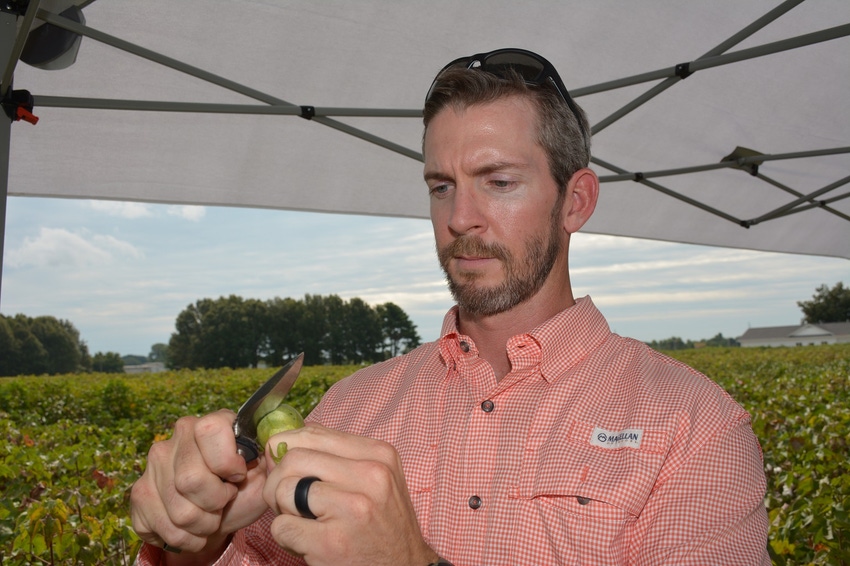
West Tennessee cotton farmers have a tough call to make in the next few days, depending on what tropical storm Gordon brings to the area.
Late predictions indicate little rainfall may hit the area, but cotton needs warm, clear days to apply harvest aid materials to get the crop prepped.
Tyson Raper, University of Tennessee Extension cotton specialist, addressed the dilemma Wednesday during the West Tennessee Agricultural Research and Education Center’s Cotton Field Day in Jackson.
Raper said some growers are ready to apply those harvest aid materials now. “Gordon will delay defoliation in many cases,” he said. “We would be picking some cotton late next week if we could spray now, but that’s early, thin, droughty cotton.”
He said some of the better acreage will be ready around Sept. 20, “with good weather.”
Tyler Sandlin, Auburn University Extension crop specialist, said Gordon is not the only concern.
“It’s a tough call with Gordon. Now, they are saying West Tennessee and North Alabama will not get all that much rain from the storm, but the 10-day outlook shows a 40 percent chance of rain seven of those days.”
Picking the best time to defoliate under those conditions will be tricky, he said. Ideally, growers need a warm, clear day to apply harvest aids and then no rain for several days.
“Options are to defoliate when the crop is ready or to wait until weather improves,” he said. Either option carries risk.
“If they apply harvest aids and then rain starts in, the treatment may not be effective. And if they wait, it might start raining and they lose yield and quality.”
He says applying harvest aids on a day with rain forecast for the following day is risky. Some products require at least 24 hours to be effective.
“Also, temperature is the key to get products to work. With cooler temperatures, we may need to think about increasing rates. Just three or four degrees makes a difference.”
Ideal Conditions
Sandlin said his ideal day to apply harvest aids would be “60 percent to 70 percent humidity and 83 degrees. We want mild, warm temperatures and humidity, but not rain.”
And the following few days need to be clear.
Finding a window in the next two weeks with those ideal conditions might be difficult.
Sandlin also discussed how to determine crop maturity. “Percent open bolls is a common practice,” he said. “But that does not consider yield fruiting gaps. At 60 percent open bolls, it’s usually safe to defoliate, but that may not account for those fruiting gaps.”
Nodes above cracked boll is another option.
He cautions growers not to sacrifice bolls that are ready to open while waiting on one more that may never be ready to harvest.
Varietal Differences
He also says variety makes a difference. “Some varieties will be ready at 50 percent open bolls. Farmers also should assess varieties that tend to produce high mic or low mic differently.
“Slicing bolls,” he added, “is the most accurate way to determine maturity. Mature bolls are difficult to cut and will display dark seed coats, folded cotyledons and an absence of jelly,” he said.
Regardless of any other means of assessing maturity, slicing bolls should be part of the process. “Use multiple techniques, but you have to slice bolls.”
He said coverage is critical for effective harvest aid application. “Stay away from the kind of tips you use to apply the new herbicide technology. Hollow cones and flat tips are better.”
Water volume makes a difference, too. A 10-gallon or even 15-gallon spray volume may require more fill-ups, but coverage and result is better.
Harvest aid product selection could include a hormonal or a herbicide product. “We’re trying to produce ethylene in the plant, so the leaves have a clean abcission and do not stick.”
Sandlin says most growers hope to use a one-pass harvest aid program. Typically, that could be something like thidiazuron 2 to 3 oz/acre + Folex 6 EC 4.0 oz + ethephon 21 oz/acre.
Several other combinations are available and high-growth cotton, droughty cotton and weather conditions may alter the selection. In some cases, two passes will be necessary.
Raper and Sandlin say a product containing thidiazuron, 2 to 3 ounces, is important to prevent regrowth.
“You don’t want to spend all season making a good crop, do a good job of defoliation, and then catch a rain that promotes regrowth that results in stained cotton and discounts.”
For more information on harvest aids check here https://bit.ly/2wK3nkV.
About the Author(s)
You May Also Like






